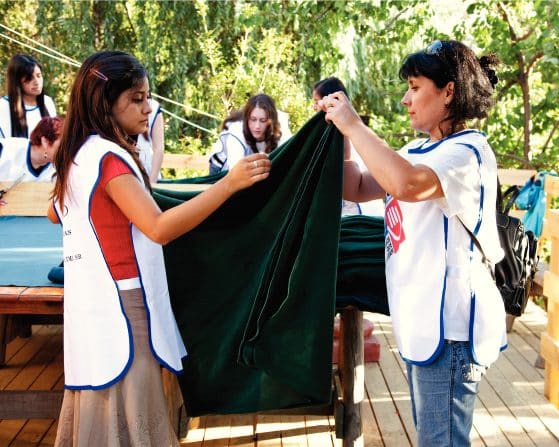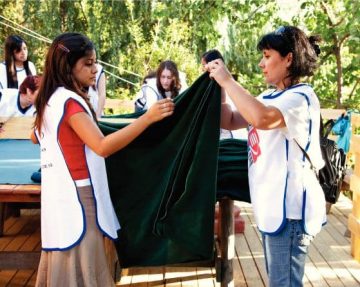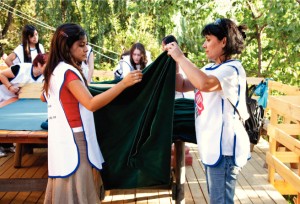How can I be more Christlike in my service to others?
I think we often use “Christlike” as a sort of synonym for “nice and Gospely.” When we are told to be more Christlike, often it is in a context that means “stop gossiping and start being kind.” I don’t disagree with that interpretation, but I thought a fruitful approach to this lesson would be to really pull apart the characteristics that defined Christ’s service to others, and then consider how to emulate those elements.
Christ was powerful in his service
Christ performed many miracles we cannot hope to replicate. Class members could read or tell a few stories in this category, such as raising Lazarus from the dead, performing the Atonement or many examples of healing.
Though we cannot raise the dead, we have the potential to be very powerful in our service. Like many people I have been horrified and deeply upset by the stories of refugees trying to find asylum and a better life in Europe, only to meet with death or misery. There are also many terrible experiences of migrants seeking to enter the United States and having their families torn apart. If your girls are blithely unaware of these situations, perhaps some discussion of a world event that touches you could bring a modern example that shows suffering was not only a reality of the Savior’s life.
How can Young Women be powerful in their service?
The refugees are in an ultimate situation of powerlessness. Though teenage girls might not think they are powerful, by comparison they have a great deal of strength, wealth and influence. Brainstorm ways to be powerful as you serve.
- In a democracy, your voice is powerful because you control who gets to be in government. Writing letters to representatives about your concern, signing petitions and participating in social media campaigns can pressure your government to act on issues. Nations have great power to serve.
- Even a small amount of wealth as a donation to a reputable cause can go a long way when many contribute.
Christ served intimately
Have the girls read examples of miracles of healing that the Savior performed and note some common elements. I noticed again and again that the Savior touched people who were sick, or blind, or lame. He touched blind eyes, he held lepers.
How can physical touch (in appropriate circumstances) be healing or be a form of service? When in your life have you felt a hug, or someone touching your hand made a difference? Who might be in need of someone to sit close, to make eye contact, or to hug?
In a few cases touching may not be safe with some highly contagious diseases. However, in many cases those who are ill or disabled may feel isolated, as others look then look away or keep their distance. The elderly are another good example of people who need attention and physical touch.
Have the girls write in journals or on a piece of paper specific people they can think of who might need this kind of service and make a plan (which they can share or not) for how to perform it.
The primary song “I’ll walk with you” is a good tie-in for this type of service. You could have one of the girls read the words, play a recording of the song while they write thoughts or sing it together.
Christ Served Everyone
The Atonement is the ultimate example of his universal and collective act of service. However, it is also easy to pull examples of the diversity of the people he served.
As you read examples, write categories on the board and brainstorm modern equivalents the girls might encounter, and how they might serve.
These included:
- Outcasts – The woman taken in adultery or lepers. (John 8:3) (Luke 17:12-16)
- Are there fellow students at school who are not included? Who might face rejection or persecution?
- Powerful people – Jesus healed the servant of the centurion. (Matt 8:5-13)
- How can girls be of service to authority figures?
- His family – He turned water into wine as a service to his mother (John 2:1-11)
- How can you serve your family members?
- His friends – He saved Peter from drowning (Matt 14:22-33)
- Young people – Jesus healed the boy whose seizures caused him to fall into the fire and the water. (Mark 9:23)
- Older people – Most of his miracles were performed to help adults.
- People with obvious problems – Lepers had visible legions and were also required to alert others to their presence. (Luke 17:12-16)
- People whose problems were not obvious – Jesus knew the heart and history of the woman at the well (John 4)
As I studied I thought of many other attributes that Christ exhibited in serving others. Depending on the needs of your class these may be helpful avenues of discussion.
Christ listened. Sometimes we assume we know what kind of service other people need and hurry to do it without asking them what they want or wish for.
Christ followed through. He didn’t offer service and then not do it. People came to him because they knew he would truly help. Nowhere do we read of him saying, “If there’s anything I can do…” as he walked out the door.
Christ didn’t discuss those he served. He specifically asked people not to publicize his miracles. Similarly as we serve, we shouldn’t then go and discuss the private struggles of those in need without their permission.
He allowed others to serve him. When the woman washed his feet with perfume, tears and her hair, he allowed her to do so and accepted her service gratefully. He also was willing to ask others to serve. He commended the care of his mother to his apostle John, asking him to serve his family. Similarly we need to be willing to allow others to help us.
What other attributes of Christ do you think of when you considered how he served?
This lesson plan was originally posted in 2015 as Young Women lesson: How can I be more Christlike in my service to others?







4 Responses
[…] Young Women Lesson: How can I be more Christlike in my service to others? […]
This was such a beautiful and thoughtful lesson. Thank you for the time and care that you took. I especially love the relevance you bring by tying it to very real needs and suffering in our day, that we and the young women can help alleviate, as well as the two lists at the end. The scriptural examples are powerful, as are the broader lessons taught, like listening and sometimes letting people serve us.
This is such a fantastic lesson plan, thank you!!! I am teaching this one next month and love the examples you’ve given.